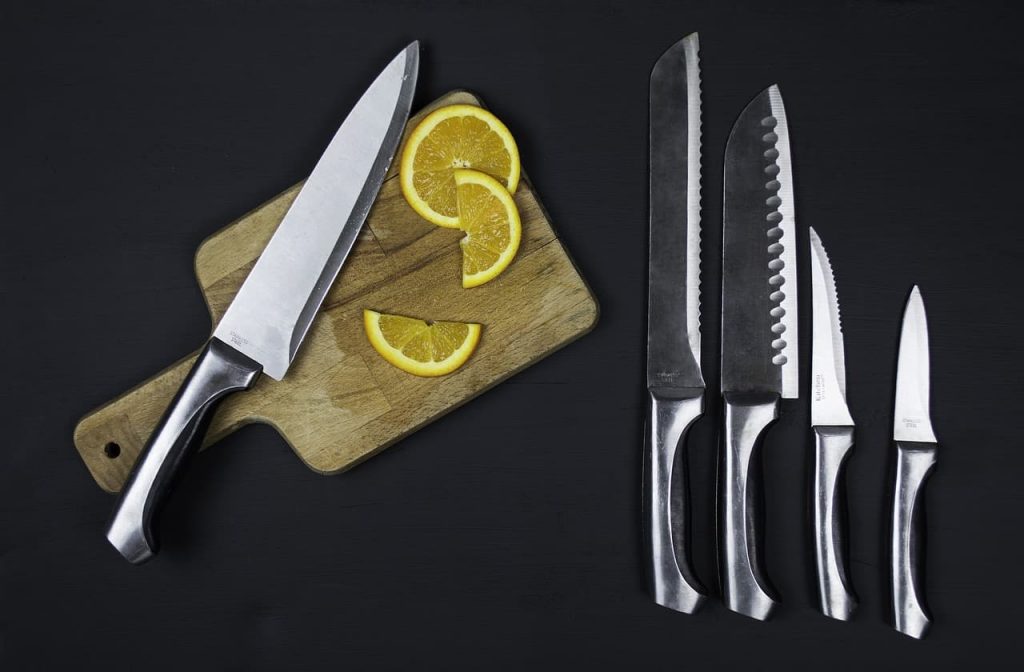When it comes to the kitchen, there are few things that you need more than good kitchen knives. A dull or poorly-designed blade can make even simple tasks like slicing bread and cutting vegetables frustrating and challenging. But when you have the right knife for the job, your time in the kitchen will be so much easier and satisfying! In this blog post, we’ll discuss everything you need to know about choosing knives: what they’re used for, how many different types of knives exist, which one is best for each task, etc.
Chef’s knife
French Chef’s knife
A long blade that starts wide and then tapers. Every Chef works like this in movies.
Serbian Chef knife, Chines knife
A sturdy and durable blade with a lot of heft. It is larger than the other knives you will use in your kitchen. This type of knife can be used for almost any food preparation task, such as dicing vegetables or slicing meat (although it’s not ideal for cutting bones). The length of the blade from tip to handle is about 12 inches.
Santoku Kitchen Knife
This is often called the “Asian Chef’s Knife” because it resembles the traditional Japanese style of knives used to cut fish and vegetables in Asian cuisine. This type of knife has an even wider blade than other kitchen knives, and its straight edge makes it a good choice for chopping.
What is it used for?
Everything you’ll need to cook in the kitchen. Slicing, chopping, and if we’re good at it, filleting it are all possibilities. There’s a separate section on how to use it and maintain a firm grip since mastering only a few fundamental skills has cut both the time spent using the knife and the likelihood of injuring ourselves with it.
Who should have Chef’s knives at home?
It can be used for almost anything, and it has endless applications. It’s also said that there’s not much else you’ll need in the kitchen (in his book The Chef’s Confessions, Anthony Bourdain explains how important a good chef’s knife is through lengthy paragraphs). If all you want is just one knife, get a chef’s knife; but don’t expect it to be perfect for everything.
Filleting knife and boning knife
A long and thin blade with a sharp point for cutting around bones. Kitchen knives like these are designed to make it easy to remove the meat from poultry, fish, and game.
Fillet knife
A small and very thin blade with a flexible edge. Kitchen knives like these are commonly used to remove fish bones without wasting any meat.
Boning knife
A small, sturdy blade with a curved edge; this type of knife is specially designed to remove the bones from poultry or fish without wasting any meat. Kitchen knives like these are handy if you enjoy making dishes that require a lot of boning (like a duck).
Cleaver
A large, heavy kitchen knife with a rectangular blade. One of the heaviest types of blades that you’ll find; this type of knife is commonly used to cut through bones. Kitchen knives like these are perfect for making your food preparation tasks much easier, especially if you plan on preparing with lots of meat and bone cutting.
Carving Knife
A long, thin blade with a pointed tip and a straight edge for cutting meats. Kitchen knives like these are perfect if you want to make quick work of large pieces of meat while keeping the amount of sawing or hacking that’s required on your part to a minimum.
Serrated Knife
A large kitchen knife with outward-curved blade teeth; this type of knife is used for cutting bread and tomatoes without crushing them. Kitchen knives like these are highly versatile and can be used for slicing light, soft foods (like bread or tomatoes) and carving meat with bones in it.
Bread Knife
A long, thin blade that’s serrated on both sides; Kitchen knives like these are commonly used to cut through bread without crushing it or tearing it apart (it can be tricky to use them to slice non-bread items). Kitchen knives like this one work best if you plan on cutting through bread without crushing it or tearing it apart. Kitchen knives like these are commonly used to cut through bread without crushing it or tearing it up.
Paring knife
A small kitchen knife that has a short blade (it usually measures about three inches). Kitchen knives like these are helpful for almost any type of food preparation and can even peel vegetables.
These blades should only be used by people who have experience handling knives because they’re so small and delicate.
Chopping knife
A short, heavy kitchen knife with a thick blade that tapers to a sharp point. Kitchen knives like these are used to chop ingredients (especially meat) without getting too dirty or wasting any of them.
Ham knife
A long, thin blade with a rounded tip made for cutting through cooked meat without damaging the dish itself. Kitchen knives like these are great if you plan on serving ham or other types of cured meats at your next event.
Cheese knife
A long, thin blade with a rounded tip and holes that prevent soft or semi-hard cheeses from sticking to it.
Kitchen knives like this one work great if you plan on cutting through small blocks of cheese (even the stickier, more difficult to cut types) without creating any mess.
Oyster knife
A short, strong blade with a thick handle and a fan-shaped tip is used for shucking oysters. Kitchen knives like these are perfect if you plan on preparing raw oysters or other types of shellfish that need to be opened before they can be eaten (they’re also useful for opening clams).
Fruit knife
A long, thin blade with a pointed tip and a sharp edge that’s used for cutting fruit. These can make quick work of any type of soft or semi-soft food item (they’re also great if you want to avoid wasting any part of the fruit).
Electric knife
A knife that’s powered by electricity and has a serrated blade. Kitchen knives like these are commonly used for carving cooked meats, but they can also be used to slice other foods (you could even use them on bread).
If you plan on using a knife for carving meat or bread, Kitchen knives like this one are perfect for the job.
Does it matter whether the knife is forged or stamped?
The type of metal used in a blade can have an effect on its flexibility and sharpness (forged blades are usually stronger). Kitchen knives like these are often made using one piece of metal. Kitchen knives like these are often made using a combination of metals, and some manufacturers even use plastic to reinforce the blade (which can affect its sharpness).
What Kitchen Knives Do You Need?
It all depends on what you want to do in the kitchen! My recommendation is that if you’re going for a full set of knives, get one Chef’s knife (which can be used for almost anything), a paring knife (perfect for small tasks), a fillet knife (for removing bones from meat or fish), and a cleaver (ideal if you plan on preparing Asian dishes). The more knives that are in your set, the better.
This is what I would recommend to anyone who wants to do some cooking at home without breaking their budget, but remember that if you’re going to get more specific, there are tons of other types of knives out there.
Last updated: September 24, 2023



Comments are closed.